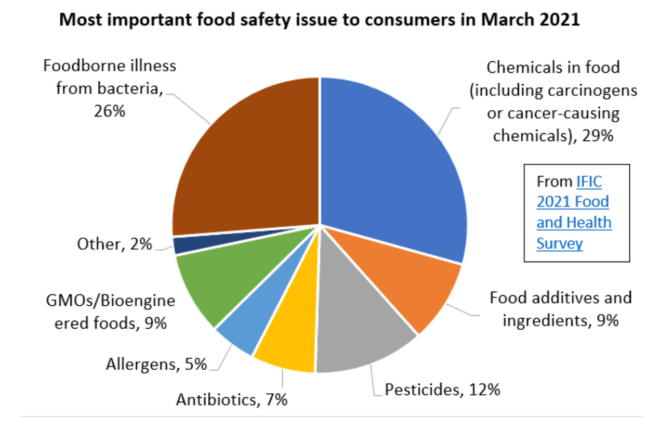Many consumers are committed to organic products for reasons that are more emotional than logical.
They frequently define their purchasing choices in terms of what they consider to be “wholesome and natural,” which often translates to the absence of “synthetic” inputs such as fertilizer and pesticides. For some, the prohibition on “genetically modified” crops (however they might be defined) is another consideration. Sometimes, they assume that in some vague way, organic agricultural practices are better for the planet.
In short, on their dinner table they want something like the farm of the idealized “Old McDonald” children’s tune that many of us grew up with. The reality is very different.
On June 23rd, the FDA reported a multistate outbreak of hepatitis A virus due to contaminated organic strawberries that were imported fresh from Baja California, a state in northern Mexico, and imported to the United States under the FreshKampo and HEB brands. As of early July, 18 outbreak-associated cases had been reported from three different states (California, Minnesota and North Dakota), and 13 people were hospitalized as a result. The Public Health Agency of Canada and the Canadian Food Inspection Agency are also investigating an outbreak of hepatitis A which is likely linked to the FreshKampo organic strawberries.

Those numbers are likely incomplete, as many cases may not have been reported, and the outbreak may not be over. Many people purchase fresh summer strawberries and freeze them, a process which will not kill hepatitis A virus when defrosted and consumed. Thus, it is possible that new infections will continue for weeks or months.
The recent incident is reminiscent of a 2013 outbreak caused by a mixture of frozen organic berries and pomegranate seeds sold by Costco and Harris Teeter stores under the brand name Townsend Farms. More than 150 people were infected in eight states, and 59 were hospitalized. Sequencing of the viral RNA revealed that the strain of virus originated in pomegranate seeds sourced from a farm in Turkey. There were small variations among the virus sequences isolated from patients who fell ill from this outbreak, and because Hepatitis A is spread most often via the fecal-oral route, the most likely scenario is that the outbreak originated from Turkish sewage that harbored Hepatitis A virus from the excreta of several different individuals.

The news of the outbreak must have come as a shock to those health-conscious consumers who purchased a berry product whose package depicted an all-American homestyle family farm in Oregon and boasted, “Since 1906, Field to Farm to Family.” Consumers would likely think they were purchasing a product from a trustworthy, salt-of-the-earth, domestic farm, rather than an international product with a much sketchier source and dubious safety standards.
Such incidents are not uncommon. A 2016 study of foodborne outbreaks in the US found that the number of outbreaks associated with organic foods is greater than those stemming from conventionally grown ones. The authors found that between 1992 and 2014, 18 outbreaks were caused by organic foods, and eight of those occurrences were specifically associated with organic produce.
One of the largest outbreaks of food contamination in modern times came from contaminated bean sprouts grown organically on a farm in Northern Germany in 2011. The culprit was the deadly and toxic E. coli strain 0104:H4, which infected almost 3,000 people, of whom about 800 experienced hemolytic uremic syndrome, which can cause neurological damage and kidney failure. Scores were hospitalized, and at least 31 people died. The fact that organic farming uses manure instead of chemical fertilizers raises a red flag for potential E. coli contamination. After weeks of painstaking investigation, a small organic farm with 15 workers was identified as the source of the outbreak.

Organic standards do not directly address food safety issues such as microbial contamination, which can be difficult to address, particularly on a global scale. The big picture is complex and daunting. Organic is now a global enterprise, and even “certified organic” produce can include imports, contaminated or not, from other parts of the world such as Turkey or Mexico.
A revealing example of the chicanery that occurs at the consumers’ end of the organic supply chain was holier-than-thou Whole Foods importing large amounts of its supposedly “organic” produce from China, of all places. Those imports even included Whole Foods’ house brand, “California Blend.” (Yes, you read that correctly: It came from mainland China.) The company insisted that “organic” certification of Chinese imports is valid and just as strict and reliable as in the United States.
Such dubious organic imports are an especially weak link. A landmark report issued in September 2017 by USDA’s Inspector General after a yearlong investigation exposed the systematic failure of government officials to ensure the integrity and safety of organic food imports. Over the past several years, there has been a huge spike in organic imports — particularly corn and soybeans — to keep pace with consumer demand; more than 100 countries now ship supposedly organic products here. The USDA’s National Organic Program (NOP) is tasked with making sure those countries meet our rigorous organic standards, but they employ a loophole-ridden system largely based on reciprocity and good faith, rather than tight controls and federal enforcement. Moreover, USDA is in the untenable and arguably unethical position of both promoting and regulating organic products.
The USDA Inspector General found widespread problems with the National Organic Program that could result in “reduced U.S. consumer confidence in the integrity of organic products imported into the United States.” The report cites the agency’s failure to reconcile organic standards among different countries, verify documents at U.S. ports of entry, and conduct mandatory audits of major exporters. The inspector general also discovered that not only are prohibited pesticides are being used on organic shipments, but that the government’s ability to detect them is virtually non-existent:

Imported agricultural products, whether organic or conventional, are sometimes fumigated at U.S. ports of entry to prevent prohibited pests from entering the United States. [USDA’s Agricultural Marketing Service] has not established and implemented controls at U.S ports of entry to identify, track, and ensure that treated organic products are not sold, labeled, or represented as organic. As a result, U.S. consumers of organic products have reduced assurance that foreign agricultural products maintain their organic integrity from farm to table.
To leave no doubt about its findings, the report concluded that National Organic Program officials have performed so poorly that fraud and corruption are common throughout the supply chain in a burgeoning food sector that claims to be healthier, safer and more eco-friendly than non-organic food. Thus, many consumers are paying a large premium to buy imported organic foods that aren’t organic at all.
The mainstream media have finally discovered the scandal of the organic food industry. The Washington Post published three investigative reports (here and here, and the one cited below) on the lucrative but fraudulent organic business, exposing organic milk producers who did not meet federal regulations, and tracking the importation of millions of pounds of falsely labeled organic grains from Eastern Europe. Post reporter Peter Whoriskey described three shipments of imported, supposedly organic corn and soybeans that were “large enough to constitute a meaningful portion of the U.S. supply of those commodities. All three were presented as organic, despite evidence to the contrary.”
But here’s the irony of ironies: With respect to food safety, consumers who are being bamboozled into buying conventional food masquerading as organic might actually be better off. Organic foods are notorious for contamination. According to Bruce Chassy, professor of food science at the University of Illinois, “Organic foods are recalled 4 to 8 times more frequently than their conventional counterparts.” (Personal communication, July 1, 2017)
That is hardly surprising. Aside from the presence of pathogenic bacteria, organic grains are particularly susceptible to toxins from fungi. Here’s why… Every year, scores of packaged food products are recalled from the U.S. market because of the presence of all-natural contaminants such as insect parts, toxic molds, bacteria and viruses. Because farming takes place outdoors and in dirt, such contamination is a fact of life. Over the centuries, the main culprits in mass food poisoning have often been mycotoxins, such as ergotamine from ergot or fumonisin from Fusarium species. These come from the fungal contamination of unprocessed crops, which is exacerbated when insects attack food crops, opening wounds in the plant that provide an opportunity for pathogen invasion. Once the molds get a foothold, poor storage conditions also promote their post-harvest growth on grain.

Fumonisin and some other mycotoxins are highly toxic, causing fatal diseases in livestock that eat infected corn and esophageal cancer and neural tube defects in humans. Regulatory agencies such as the U.S. FDA and UK Food Safety Agency have established recommended maximum fumonisin levels in food and feed products made from corn. Unprocessed or lightly processed corn (e.g., corn meal) can have fumonisin levels that exceed recommended levels. In 2003, the UK Food Safety Agency tested six organic corn meal products and 20 conventional (non-organic) corn meal products for fumonisin contamination. All six organic corn meals had elevated levels—from nine to 40 times greater than the recommended levels for human health—and they were voluntarily withdrawn from grocery stores. By contrast, the 20 conventional (i.e., non-organic) products averaged about a quarter of the recommended maximum levels.
A well-funded and organized campaign by the organic and natural products industries enables activists to foment spurious health, safety, and environmental fears about the agricultural products and production techniques used to grow non-organic foods, especially those made with modern molecular genetic engineering techniques. What’s ironic is that though the organic lobby positions its industry as a green alternative to conventional agriculture, it’s actually more harmful to the environment.
A prevalent “green myth” about organic agriculture is that it does not employ pesticides. Organic farming does, in fact, use insecticides and fungicides to prevent predation of its crops. More than 20 chemicals are commonly used in the growing and processing of organic crops and are acceptable under the U.S. Department of Agriculture’s arbitrary and ever-shifting organic rules. Many of those organic pesticides are more toxic than the synthetic ones used in conventional farming.
But the fatal flaw of organic agriculture is the low yields that cause it to be wasteful of water and farmland. Plant pathologist Steven Savage of the CropLife Foundation analyzed the data from the USDA’s 2014 Organic Survey, which reported various measures of productivity from most of the certified organic farms in the nation, and compared them to those at conventional farms. His findings were extraordinary. In 59 of the 68 crops surveyed, there was a yield gap, which means that, controlling for other variables, organic farms were producing less than conventional farms. Many of those shortfalls were large: for strawberries, organic farms produced 61 percent less than conventional farms; for tangerines, 58 percent less; for cotton, 45 percent less; and for rice, 39 percent less.
As Savage observed: “To have raised all U.S. crops as organic in 2014 would have required farming of 109 million more acres of land. That is an area equivalent to all the parkland and wildland areas in the lower 48 states, or 1.8 times as much as all the urban land in the nation.”

Perhaps the most illogical and least sustainable aspect of organic farming in the long term will turn out to be the absolute exclusion of “genetically engineered” plants that were modified with the most precise and predictable modern molecular techniques. Except for wild berries and wild mushrooms, virtually all the fruits, vegetables, and grains in our diet have been genetically improved by one technique or another—often as a result of seeds having been irradiated or via “wide crosses,” which move genes from one species or genus to another in ways that do not occur in nature. (These more-primitive techniques of genetic modification are acceptable in organic agriculture.)
In recent decades, we have seen genetic engineering advances such as plants that are disease-, pest-, drought-, and flood-resistant. The result has been higher yields for farmers and lower costs for consumers. As genetic engineering’s successes continue to emerge, the gap between the methods of modern, high-tech agriculture and organic agriculture will become a chasm, and organic will be increasingly unable to compete.
The bottom line is that if you care about price, quality, safety, or benefit to the environment, you’re better off avoiding organic products of all sorts.














 What is soil organic matter?
What is soil organic matter?

